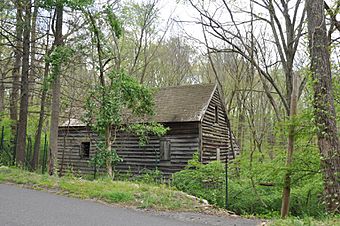Sylvanus Selleck Gristmill facts for kids
Quick facts for kids |
|
|
Sylvanus Selleck Gristmill
|
|
 |
|
| Location | 124 Old Mill Rd., Greenwich, Connecticut |
|---|---|
| Area | less than one acre |
| Built | c. 1796 |
| Architect | Selleck, Sylvanus; Knapp, Edwin |
| NRHP reference No. | 90001109 |
| Added to NRHP | August 2, 1990 |
The Sylvanus Selleck Gristmill is a very old and special building in Greenwich, Connecticut. It's also called the Edwin Knapp Gristmill. This historic gristmill was built around 1796, making it one of the oldest mill buildings in all of Connecticut! It's a rare example of how buildings were put together a long time ago. Because it's so important, it was added to the National Register of Historic Places in 1990.
About the Selleck Gristmill
The Sylvanus Selleck Gristmill is found in a quiet, country part of northern Greenwich. It sits close to Old Mill Road. The land here slopes down towards a small stream called Converse Pond Brook.
What is a Gristmill?
A gristmill is a type of mill that grinds grain, like wheat or corn, into flour or meal. Farmers would bring their harvested grains to the mill. The mill would then use large grinding stones, often powered by water, to turn the grain into useful products for baking and cooking.
How the Mill Looks
The mill building is made of wood. It has a sloped roof and wooden siding. A smaller section with a sloped roof sticks out on the downhill side. The building sits on a strong stone base. This base is fully visible on the downhill side.
Inside, the building was made with strong oak and chestnut beams. These beams had extra supports called "bracing." This bracing helped the building hold up the heavy milling machines. A stone channel, called a tailrace, goes out from the building. This channel used to guide water back to the stream.
History of the Mill
Sylvanus Selleck built this mill around 1796. It is one of only two known mill buildings from the 1700s still standing in Connecticut. Selleck was a farmer. He likely built the mill to earn extra money by grinding grain for other farmers nearby.
Around 1850, Edwin Knapp added a part to the mill. The mill is a rare example of "braced-frame construction." This building style was once very common. The mill kept working until Edwin Knapp passed away in 1895.



